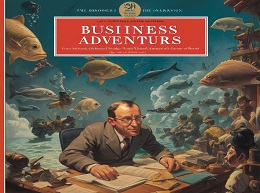Bankable Business Plans

Crafting Success: A Comprehensive Review of "Bankable Business Plans"
Creating a compelling business plan is a critical step for any entrepreneur seeking to secure funding and achieve long-term success. Edward G. Rogoff's "Bankable Business Plans" offers a detailed and practical guide for crafting business plans that appeal to investors and lenders. This review will explore the key themes, principles, and practical insights presented in the book, providing examples and subheadings to engage readers and highlight the essential components of a bankable business plan.
The Premise
Rogoff emphasizes that a business plan is not merely a document but a strategic tool that can make or break a startup. The book guides entrepreneurs through the process of developing a business plan that is both comprehensive and persuasive, addressing the concerns of potential investors and ensuring that the business idea is viable.
Example: A Tech Startup's Journey
Consider a tech startup seeking venture capital. Without a solid business plan, the founders may struggle to convey their vision, market potential, and financial projections. Rogoff's guidance can help them create a plan that showcases their innovation and market opportunity, ultimately attracting the necessary investment.
Understanding the Audience
Rogoff stresses the importance of knowing your audience whether they are venture capitalists, angel investors, or banks. Each type of investor has different expectations and criteria for evaluating business plans.
Practical Insight: Tailoring the Plan
For instance, a bank might focus more on cash flow projections and collateral, while a venture capitalist might be more interested in the growth potential and scalability of the business. Understanding these differences allows entrepreneurs to tailor their plans accordingly.
The Executive Summary: Your First Impression
The executive summary is arguably the most critical part of the business plan. It serves as the first impression and determines whether the reader will continue reading.
Example: An Innovative Retail Concept
Imagine an entrepreneur with a unique retail concept that combines physical stores with an immersive online experience. The executive summary should succinctly describe the business idea, market opportunity, and the competitive advantage, capturing the reader's interest from the outset.
Market Analysis: Proving the Demand
A thorough market analysis demonstrates that there is a demand for the product or service. This section should include detailed research on the target market, industry trends, and competitive landscape.
Practical Insight: Utilizing Market Research Tools
Entrepreneurs can use tools like surveys, industry reports, and competitor analysis to gather data. For example, a food delivery startup might analyze market trends showing increased demand for convenience and healthy eating options, providing a strong case for their business.
Marketing and Sales Strategy: Reaching Your Customers
Rogoff highlights the need for a well-defined marketing and sales strategy. This section should outline how the business plans to attract and retain customers, including pricing, promotion, distribution channels, and sales tactics.
Example: A Subscription Box Service
A subscription box service for niche products, such as eco-friendly household items, might detail their digital marketing strategy, influencer partnerships, and customer retention programs. Clear, actionable plans demonstrate to investors that the business can effectively reach its target audience.
Operations Plan: Turning Vision into Reality
The operations plan describes how the business will function on a day-to-day basis. This includes the logistics of producing and delivering the product or service, as well as the management structure and roles.
Practical Insight: Detailing the Supply Chain
For a custom furniture business, the operations plan might include details on sourcing sustainable materials, manufacturing processes, quality control, and delivery logistics. Providing a clear picture of how the business will operate helps investors understand its feasibility.
Financial Projections: Showing the Money
Financial projections are crucial in convincing investors of the business's profitability. This section should include income statements, cash flow statements, and balance sheets, as well as detailed assumptions and justifications.
Example: A SaaS Startup's Financials
A SaaS (Software as a Service) startup might project revenue growth based on subscription models, customer acquisition costs, and lifetime value. Including conservative and optimistic scenarios can demonstrate a thorough understanding of the business's financial potential.
Risk Analysis: Preparing for Uncertainties
Identifying potential risks and outlining mitigation strategies shows investors that the entrepreneur is prepared for challenges. This includes market risks, operational risks, and financial risks.
Practical Insight: SWOT Analysis
Conducting a SWOT (Strengths, Weaknesses, Opportunities, Threats) analysis can help entrepreneurs identify and address potential risks. For instance, a new e-commerce platform might recognize competition as a threat and plan strategies to differentiate itself.
The Importance of Visuals
Rogoff emphasizes the use of visuals such as charts, graphs, and tables to make the business plan more engaging and easier to understand. Visual aids can help highlight key data and make complex information more digestible.
Practical Insight: Infographics
For example, a startup might use infographics to depict their market research findings, customer segmentation, and financial projections. Visuals can enhance the overall presentation and make the plan more compelling.
The Role of Appendices
The appendices can be used to provide additional information that supports the main sections of the business plan. This might include resumes of key team members, detailed market research data, or technical specifications.
Example: A Biotechnology Firm
A biotechnology firm might include detailed research studies, regulatory approvals, and patents in the appendices. This additional information can provide investors with the confidence that the business is well-prepared and credible.
The Iterative Process
Rogoff advises that creating a business plan is an iterative process. Entrepreneurs should be prepared to revise and refine their plans based on feedback from mentors, advisors, and potential investors.
Practical Insight: Seeking Feedback
Regularly seeking feedback from experienced entrepreneurs, industry experts, and potential investors can help identify weaknesses and areas for improvement. For instance, a clean energy startup might adjust their financial projections based on input from industry analysts.
The Enduring Value of a Bankable Business Plan
"Bankable Business Plans" by Edward G. Rogoff is an invaluable resource for entrepreneurs at any stage of their journey. The book provides a comprehensive roadmap for creating a business plan that not only articulates a clear vision but also demonstrates feasibility and profitability to potential investors. By following Rogoff's detailed guidance, entrepreneurs can craft business plans that stand out, attract funding, and lay the foundation for long-term success.












